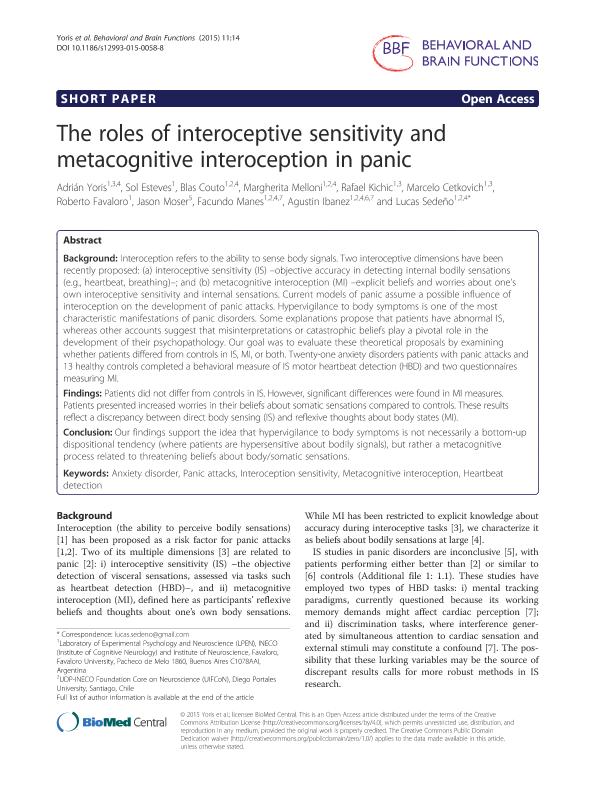Artículo
The roles of interoceptive sensitivity and metacognitive interoception in panic
Yoris Magnago, Adrián Ezequiel ; Esteves, Sol; Couto, Juan Blas Marcos
; Esteves, Sol; Couto, Juan Blas Marcos ; Melloni, Margherita
; Melloni, Margherita ; Kichic, Rafael; Cetkovich Bakmas, Marcelo Gustavo; Favaloro, Roberto; Moser, Jason; Manes, Facundo Francisco
; Kichic, Rafael; Cetkovich Bakmas, Marcelo Gustavo; Favaloro, Roberto; Moser, Jason; Manes, Facundo Francisco ; Ibañez, Agustin Mariano
; Ibañez, Agustin Mariano ; Sedeño, Lucas
; Sedeño, Lucas
 ; Esteves, Sol; Couto, Juan Blas Marcos
; Esteves, Sol; Couto, Juan Blas Marcos ; Melloni, Margherita
; Melloni, Margherita ; Kichic, Rafael; Cetkovich Bakmas, Marcelo Gustavo; Favaloro, Roberto; Moser, Jason; Manes, Facundo Francisco
; Kichic, Rafael; Cetkovich Bakmas, Marcelo Gustavo; Favaloro, Roberto; Moser, Jason; Manes, Facundo Francisco ; Ibañez, Agustin Mariano
; Ibañez, Agustin Mariano ; Sedeño, Lucas
; Sedeño, Lucas
Fecha de publicación:
04/2015
Editorial:
BioMed Central
Revista:
Behavioral and Brain Functions
ISSN:
1744-9081
Idioma:
Inglés
Tipo de recurso:
Artículo publicado
Clasificación temática:
Resumen
Background: Interoception refers to the ability to sense body signals. Two interoceptive dimensions have been recently proposed: (a) interoceptive sensitivity (IS) -objective accuracy in detecting internal bodily sensations (e.g., heartbeat, breathing)-; and (b) metacognitive interoception (MI) -explicit beliefs and worries about one's own interoceptive sensitivity and internal sensations. Current models of panic assume a possible influence of interoception on the development of panic attacks. Hypervigilance to body symptoms is one of the most characteristic manifestations of panic disorders. Some explanations propose that patients have abnormal IS, whereas other accounts suggest that misinterpretations or catastrophic beliefs play a pivotal role in the development of their psychopathology. Our goal was to evaluate these theoretical proposals by examining whether patients differed from controls in IS, MI, or both. Twenty-one anxiety disorders patients with panic attacks and 13 healthy controls completed a behavioral measure of IS motor heartbeat detection (HBD) and two questionnaires measuring MI. Findings: Patients did not differ from controls in IS. However, significant differences were found in MI measures. Patients presented increased worries in their beliefs about somatic sensations compared to controls. These results reflect a discrepancy between direct body sensing (IS) and reflexive thoughts about body states (MI). Conclusion: Our findings support the idea that hypervigilance to body symptoms is not necessarily a bottom-up dispositional tendency (where patients are hypersensitive about bodily signals), but rather a metacognitive process related to threatening beliefs about body/somatic sensations.
Archivos asociados
Licencia
Identificadores
Colecciones
Articulos(SEDE CENTRAL)
Articulos de SEDE CENTRAL
Articulos de SEDE CENTRAL
Citación
Yoris Magnago, Adrián Ezequiel; Esteves, Sol; Couto, Juan Blas Marcos; Melloni, Margherita; Kichic, Rafael; et al.; The roles of interoceptive sensitivity and metacognitive interoception in panic; BioMed Central; Behavioral and Brain Functions; 11; 1; 4-2015; 1-6
Compartir
Altmétricas



